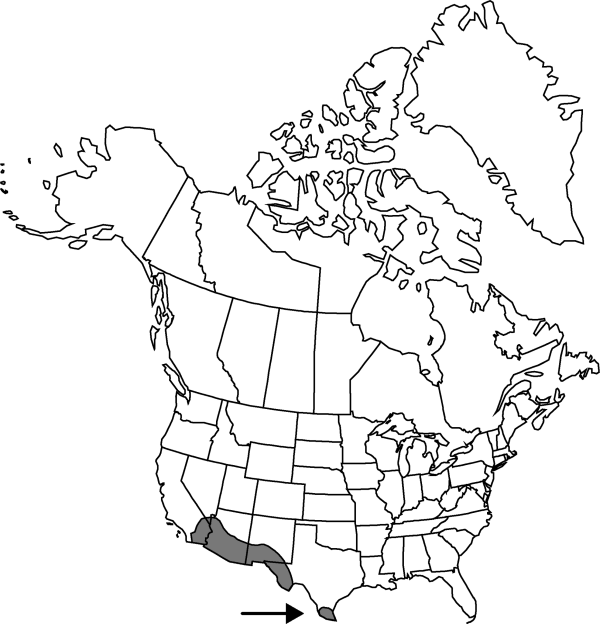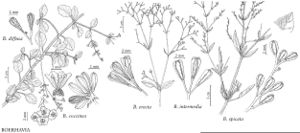Difference between revisions of "Boerhavia intermedia"
Contr. W. Bot. 10: 41, unnumbered fig. at end of is sue. 1902.
FNA>Volume Importer |
imported>Volume Importer |
||
| (7 intermediate revisions by 2 users not shown) | |||
| Line 6: | Line 6: | ||
|place=10: 41, unnumbered fig. at end of is sue. 1902 | |place=10: 41, unnumbered fig. at end of is sue. 1902 | ||
|year=1902 | |year=1902 | ||
| + | }} | ||
| + | |special_status={{Treatment/ID/Special_status | ||
| + | |code=F | ||
| + | |label=Illustrated | ||
}} | }} | ||
|basionyms= | |basionyms= | ||
| Line 11: | Line 15: | ||
|name=Boerhavia erecta var. intermedia | |name=Boerhavia erecta var. intermedia | ||
|authority=(M. E. Jones) Kearney & Peebles | |authority=(M. E. Jones) Kearney & Peebles | ||
| + | |rank=variety | ||
}} | }} | ||
|hierarchy=Nyctaginaceae;Boerhavia;Boerhavia intermedia | |hierarchy=Nyctaginaceae;Boerhavia;Boerhavia intermedia | ||
| Line 19: | Line 24: | ||
}}<!-- | }}<!-- | ||
| − | --><span class="statement" id="st- | + | --><span class="statement" id="st-undefined" data-properties=""><b>Herbs,</b> annual; taproot tapered, soft or ± woody. <b>Stems</b> usually erect or ascending, occasionally decumbent, moderately or profusely branched primarily distally, 2–6 (–8) dm, minutely puberulent with bent hairs basally, glabrous or minutely puberulent distally. <b>Leaves</b> mostly in basal 1/2 of plant; larger leaves with petiole 7–25 mm, blade broadly ovate or oval to lanceolate, 20–45 × 7–16 mm (distal leaves smaller, sometimes longer, proportionately narrower), adaxial surface usually glabrous, occasionally glandular-puberulent, often minutely punctate, abaxial surface paler than adaxial, glabrous or glabrate, usually punctate with small patches of reddish or brownish cells, base round, obtuse, or truncate, margins entire or slightly sinuate, apex acute, obtuse, or round. <b>Inflorescences</b> terminal, forked ca. 3–6 times ± evenly (or clearly unevenly), diffuse, usually with sticky internodal bands; branches strongly ascending, terminating in umbels or flowers borne singly, occasionally subumbellate (all pedicels not attaching at same point), rarely irregularly compound umbels. <b>Flowers</b>: pedicel 0.5–3.2 mm; bracts at base of perianth quickly deciduous, (1–)2, narrowly lance-acuminate, 0.5–1 mm; perianth whitish to pale pink or purplish, campanulate distal to constriction, 0.7–1.2[–2] mm; stamens 2–3, included or barely exserted. <b>Fruits</b> 1–15 per cluster, straw colored or gray-brown, obconic, broadly low conic, 2–2.8(–3.2) × 0.7–1.3 mm (l/w: 1.7–3.2), apex nearly truncate, glabrous; ribs (4–)5, acute, slightly rugose or undulate near sulci; sulci 0.2–1 times as wide as base of ribs, coarsely transversely rugose, smooth or very faintly papillate. <b>2n</b> = 52, ca. 54.</span><!-- |
-->{{Treatment/Body | -->{{Treatment/Body | ||
| + | |phenology=Flowering summer–late fall. | ||
|habitat=Sandy or gravelly areas in deserts and arid grasslands, disturbed areas | |habitat=Sandy or gravelly areas in deserts and arid grasslands, disturbed areas | ||
|elevation=[0-]100-1700 m | |elevation=[0-]100-1700 m | ||
|distribution=Ariz.;Calif.;Nev.;N.Mex.;Tex.;Mexico (Baja California;Baja California Sur;Chihuahua;Coahuila;Durango;Sonora). | |distribution=Ariz.;Calif.;Nev.;N.Mex.;Tex.;Mexico (Baja California;Baja California Sur;Chihuahua;Coahuila;Durango;Sonora). | ||
| − | |discussion=<p>Boerhavia intermedia is a wide-ranging and variable species of the arid areas of southwestern North America. Ordinarily, the terminal inflorescence is an umbel of at least a few flowers. Plants with few-flowered umbels often have only one flower at some of the terminal inflorescences. Plants with predominantly or entirely one-flowered terminal inflorescences occasionally occur in the eastern part of the range. To the west, and especially on the Coloradan portion of the Sonoran Desert and on the Baja California peninsula, plants with one-flowered terminal inflorescences are more frequent, and even though those have five-ribbed fruits, they often have been identified as B. triquetra. In that region, such plants may have proportionately broader fruits as the ribs become more winglike. Some plants in southern California bear a few fruits with four angles, and in this respect are intermediate to B. triquetra.</p> | + | |discussion=<p><i>Boerhavia intermedia</i> is a wide-ranging and variable species of the arid areas of southwestern North America. Ordinarily, the terminal inflorescence is an umbel of at least a few flowers. Plants with few-flowered umbels often have only one flower at some of the terminal inflorescences. Plants with predominantly or entirely one-flowered terminal inflorescences occasionally occur in the eastern part of the range. To the west, and especially on the Coloradan portion of the Sonoran Desert and on the Baja California peninsula, plants with one-flowered terminal inflorescences are more frequent, and even though those have five-ribbed fruits, they often have been identified as <i>B. triquetra</i>. In that region, such plants may have proportionately broader fruits as the ribs become more winglike. Some plants in southern California bear a few fruits with four angles, and in this respect are intermediate to <i>B. triquetra</i>.</p> |
|tables= | |tables= | ||
|references= | |references= | ||
| Line 34: | Line 40: | ||
-->{{#Taxon: | -->{{#Taxon: | ||
name=Boerhavia intermedia | name=Boerhavia intermedia | ||
| − | |||
|authority=M. E. Jones | |authority=M. E. Jones | ||
|rank=species | |rank=species | ||
| Line 41: | Line 46: | ||
|basionyms= | |basionyms= | ||
|family=Nyctaginaceae | |family=Nyctaginaceae | ||
| + | |phenology=Flowering summer–late fall. | ||
|habitat=Sandy or gravelly areas in deserts and arid grasslands, disturbed areas | |habitat=Sandy or gravelly areas in deserts and arid grasslands, disturbed areas | ||
|elevation=[0-]100-1700 m | |elevation=[0-]100-1700 m | ||
| Line 47: | Line 53: | ||
|publication title=Contr. W. Bot. | |publication title=Contr. W. Bot. | ||
|publication year=1902 | |publication year=1902 | ||
| − | |special status= | + | |special status=Illustrated |
| − | |source xml=https:// | + | |source xml=https://bitbucket.org/aafc-mbb/fna-data-curation/src/2e0870ddd59836b60bcf96646a41e87ea5a5943a/coarse_grained_fna_xml/V4/V4_33.xml |
|genus=Boerhavia | |genus=Boerhavia | ||
|species=Boerhavia intermedia | |species=Boerhavia intermedia | ||
| − | |||
| − | |||
| − | |||
| − | |||
| − | |||
| − | |||
| − | |||
| − | |||
| − | |||
| − | |||
| − | |||
| − | |||
| − | |||
| − | |||
| − | |||
| − | |||
| − | |||
| − | |||
| − | |||
| − | |||
| − | |||
| − | |||
| − | |||
| − | |||
| − | |||
| − | |||
| − | |||
| − | |||
| − | |||
| − | |||
| − | |||
| − | |||
| − | |||
| − | |||
| − | |||
| − | |||
| − | |||
| − | |||
| − | |||
| − | |||
| − | |||
| − | |||
| − | |||
| − | |||
| − | |||
| − | |||
| − | |||
| − | |||
| − | |||
| − | |||
| − | |||
| − | |||
| − | |||
| − | |||
| − | |||
| − | |||
| − | |||
| − | |||
| − | |||
| − | |||
| − | |||
}}<!-- | }}<!-- | ||
-->[[Category:Treatment]][[Category:Boerhavia]] | -->[[Category:Treatment]][[Category:Boerhavia]] | ||
Latest revision as of 21:57, 5 November 2020
Herbs, annual; taproot tapered, soft or ± woody. Stems usually erect or ascending, occasionally decumbent, moderately or profusely branched primarily distally, 2–6 (–8) dm, minutely puberulent with bent hairs basally, glabrous or minutely puberulent distally. Leaves mostly in basal 1/2 of plant; larger leaves with petiole 7–25 mm, blade broadly ovate or oval to lanceolate, 20–45 × 7–16 mm (distal leaves smaller, sometimes longer, proportionately narrower), adaxial surface usually glabrous, occasionally glandular-puberulent, often minutely punctate, abaxial surface paler than adaxial, glabrous or glabrate, usually punctate with small patches of reddish or brownish cells, base round, obtuse, or truncate, margins entire or slightly sinuate, apex acute, obtuse, or round. Inflorescences terminal, forked ca. 3–6 times ± evenly (or clearly unevenly), diffuse, usually with sticky internodal bands; branches strongly ascending, terminating in umbels or flowers borne singly, occasionally subumbellate (all pedicels not attaching at same point), rarely irregularly compound umbels. Flowers: pedicel 0.5–3.2 mm; bracts at base of perianth quickly deciduous, (1–)2, narrowly lance-acuminate, 0.5–1 mm; perianth whitish to pale pink or purplish, campanulate distal to constriction, 0.7–1.2[–2] mm; stamens 2–3, included or barely exserted. Fruits 1–15 per cluster, straw colored or gray-brown, obconic, broadly low conic, 2–2.8(–3.2) × 0.7–1.3 mm (l/w: 1.7–3.2), apex nearly truncate, glabrous; ribs (4–)5, acute, slightly rugose or undulate near sulci; sulci 0.2–1 times as wide as base of ribs, coarsely transversely rugose, smooth or very faintly papillate. 2n = 52, ca. 54.
Phenology: Flowering summer–late fall.
Habitat: Sandy or gravelly areas in deserts and arid grasslands, disturbed areas
Elevation: [0-]100-1700 m
Distribution

Ariz., Calif., Nev., N.Mex., Tex., Mexico (Baja California, Baja California Sur, Chihuahua, Coahuila, Durango, Sonora).
Discussion
Boerhavia intermedia is a wide-ranging and variable species of the arid areas of southwestern North America. Ordinarily, the terminal inflorescence is an umbel of at least a few flowers. Plants with few-flowered umbels often have only one flower at some of the terminal inflorescences. Plants with predominantly or entirely one-flowered terminal inflorescences occasionally occur in the eastern part of the range. To the west, and especially on the Coloradan portion of the Sonoran Desert and on the Baja California peninsula, plants with one-flowered terminal inflorescences are more frequent, and even though those have five-ribbed fruits, they often have been identified as B. triquetra. In that region, such plants may have proportionately broader fruits as the ribs become more winglike. Some plants in southern California bear a few fruits with four angles, and in this respect are intermediate to B. triquetra.
Selected References
None.
